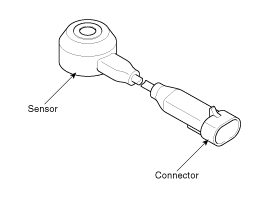 Hyundai Equus: Knock Sensor (KS) Description and Operation
Second generation VI (2009–2025) / Hyundai Equus VI 2009-2025 Service Manual / Engine Control/Fuel System / Engine Control System / Knock Sensor (KS) Description and Operation
Hyundai Equus: Knock Sensor (KS) Description and Operation
Second generation VI (2009–2025) / Hyundai Equus VI 2009-2025 Service Manual / Engine Control/Fuel System / Engine Control System / Knock Sensor (KS) Description and Operation
Second generation VI (2009–2025) / Hyundai Equus VI 2009-2025 Service Manual / Engine Control/Fuel System / Engine Control System / Knock Sensor (KS) Description and Operation
| Description |
Knocking is a phenomenon characterized by undesirable
vibration and noise and can cause engine damage. Knock Sensor (KS) is
installed on the cylinder block and senses engine knocking.
When knocking occurs, the vibration from the cylinder block
is applied as pressure to the piezoelectric element. When a knock
occurs, the sensor produces voltage signal. The ECM retards the ignition
timing when knocking occurs. If the knocking disappears after retarding
the ignition timing, the ECM will advance the ignition timing. This
sequential control can improve engine power, torque and fuel economy.

 Camshaft Position Sensor (CMPS) Repair procedures
Camshaft Position Sensor (CMPS) Repair procedures
Inspection
1.
Check the signal waveform of the CMPS and CKPS using the GDS.
Specification: Refer to “Wave Form”
Removal
•
DON’T remove the camshaft pos ...
 Knock Sensor (KS) Specifications
Knock Sensor (KS) Specifications
Specification
ItemSpecificationCapacitance (pF)950 ~ 1,350
...
See also:
Rear Wheel Speed Sensor Components and Components Location
Components
1. Rear wheel speed sensor cable2. Rear wheel speed sensor
...
Special Service Tools
Special Service Tools
Tool (Number and name)IllustrationUse09977-3R000Disc & hub assembly bolt removerRemoval and installation of disc & hub assembly bolt
...
Tire rotation
To equalize tread wear, it is recommended that the tires be rotated every 7,500
miles (12,000 km) or sooner if irregular wear develops.
During rotation, check the tires for correct balance.
When r ...
Categories
Hyundai Equus Manuals
© 2011-2025 Copyright www.heqmanual.com
